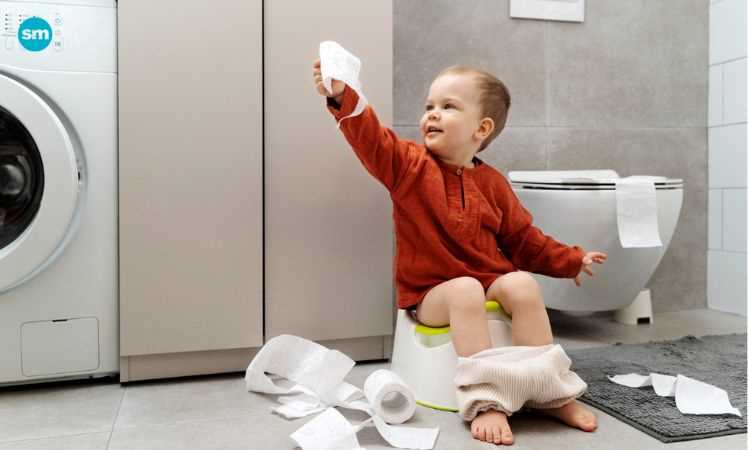Last updated on September 4, 2023 by Lori Pace
Ready to ditch the diapers? Three days of potty training may be just what you need. This method is simple but requires commitment and patience.
In this article, we’ll guide you through preparing your child, introducing them to the toilet, reinforcing daily habits, and celebrating successes.
So buckle up and start an exciting journey of independence for you and your little one. It will be challenging, but worth it!
Prepare your child for the process
Before starting the three-day potty training process, you must prepare your child to make it smoother and more effective.
Check your child’s readiness; they should be able to understand and follow simple instructions. Make sure they are emotionally ready for this new challenge and remember that this is a big step for them.
Have all necessary equipment ready, such as a potty chair, training pants, and clothing that can be easily removed. Show them relevant hygiene practices, such as washing hands thoroughly after using the potty.
Remember, parental patience is crucial during this time. Keep a positive attitude and be patient while they learn this new skill.
With the right preparation, you will help your child succeed.
Day 1: Introduction to the toilet
On the first day, you need to introduce the toilet to your child and explain its functions in a simple and understandable way. This is called toilet familiarization. Let them see you using it and explain that it’s something all adults do. Make it fun and maybe decorate it with their favorite cartoon characters.
Next, you need to choose the right potty. Your child should be involved in the potty selection process. Let them pick their own potty. This gives them a sense of ownership and makes them more likely to use it.
Hygiene classes are also crucial. Teach them the importance of wiping and washing hands after using the toilet. Overcoming their fears is also crucial. Assure them that they have nothing to fear and praise their bravery.
Remember, a fun introduction can make the process less intimidating.
Day 2: Intensify daily activities
Now is the time to reinforce routines and get your child used to pottying. Daily consistency is crucial the next day. Take your child to the bathroom regularly to make sure they understand this is their new normal.
Incorporate a reward system to motivate your child. Stickers or treats can work wonders in encouraging children to cooperate. Remember, this is a team effort and your child’s willingness to participate is key.
Don’t forget the importance of “bathroom talk.” Discuss this process openly with your children. Use positive language to make them feel proud and accomplished.
Finally, remember the need for patience. This process can take time, and surprises can occur. Stay calm, provide reassurance, and let them know this is all part of learning.
Day Three: Gaining Confidence
As you move on to the next level, it’s all about helping your child feel confident in their newly learned skills. Building trust in this process is crucial. Assure your child that you will support them and encourage their independence. Let them take the lead on going potty and let them overcome their fears.
Confidence boosters play an important role here. Praise your children for their progress and celebrate their successes, no matter how small. Rewarding progress will motivate your child to keep trying, even when the going gets tough. Remember, the goal is not perfection but growth. Every successful potty trip is a step in the right direction and boosts their confidence.
Keep up the good work!
Deal with setbacks and celebrate successes
During this phase, setbacks must be faced head-on and victories recognized. Dealing with incidents patiently and providing emotional support are key elements in dealing with any regression. Instead of scolding, reassure your child that everyone makes mistakes and it’s part of the learning process.
Celebrate small successes with a reward system, sticker charts, or a special treat after a successful potty break. This positive reinforcement helps motivate your child to continue improving. Progress tracking also gives you a clear picture of how they’re doing.
Remember, return management is critical to maintaining momentum. If you notice continued frustration, it might be wise to take a break and try again later. Stay positive and supportive throughout the journey.
FAQ
What are some helpful tools or resources that I can use during the three-day potty training process?
Choosing the right potty chair can increase your child’s motivation. Use training rewards to reinforce progress. In the evening, keep training. Don’t worry about surprises, they are part of the process. Remember, patience wins the potty race.
Are there specific diets or foods that can facilitate the potty training process?
Increasing dietary fiber intake and staying hydrated are key. Avoid foods that cause constipation. Balanced nutrition and structured meals can regulate bowel movements and ease toilet training. Remember, every child’s body reacts differently to food.
What are some signs that my child is not ready for three days of potty training?
If your child lacks physical preparation, doesn’t understand signals, or exhibits fear factors and emotional readiness issues, they may not be ready. Potty resistance is another clear sign that they are not ready for potty training.
Are there other methods similar to the three-day potty training method?
Yes, there are other techniques that can be considered depending on training challenges, emotional readiness, and night training. Some methods take cultural differences into account and may require more than three days to be successful.
After three days of potty training, how soon should I expect my child to be fully potty trained?
After toilet training, expect it to take a few weeks before you can become fully independent on your toilet. Use a reward system to encourage progress, handle accidents calmly, and handle nighttime training and training setbacks with patience to support your child’s journey.




